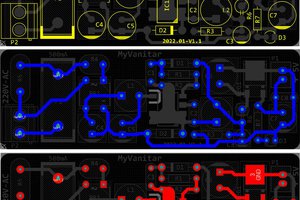Contactless AC Voltage Test
The Contactless AC Voltage tester consists of three BC849B transistors connected in cascade resulting in the final gain being the product of the gain of each transistor.
For the BC849B transistor gain averages 220, giving an overall average gain of 10.48E+6.
The AC voltage being detected (~3*Vbe min), is isolated from direct contact with the transistor base via the source wire insulation and the resistivity of the air at ~2x10E16 (Ωm), subject to temperature and humidity resulting in a very low base current.
The antenna rather than a separate length of wire is an integrated copper trace coil on the reverse side of the PCB.
Due to the low battery voltage of 3V powering the circuit and to reduce current consumption it is recommened to use low current high efficiency LED's.
Usage simply requires turning the test tool on and placing it with the antenna in close proximity to the cable or wire connected to a mains AC supply upon which the LED will illuminate.
Square Wave Generator
The signal generator can be used for troubleshooting in audio and IF stages due to the infinite number of odd harmonic frequencies extending beyond the fundamental.
The square wave generator is based around a Timer (555 or equivalent), using one resistor and one capacitor to create a 1khz square waveform with 1:1 mark space ratio.
For the required frequency the CR values are 100nF & 7K1 (comprising 5k1+2k).
Frequency = 1/(1.4*CR) = 1/(1.4*100nF * 7K1) = 1006.03Hz. Measured as 1008Hz.
The output of the timer has a 1KR series resistor connected to prevent excessively loading the output if connected to a short circuit.
Continuity/Diode Test
The continuity/diode test as its name indicates checks continuity <=2R and diodes.
Indication is given by two LED's one per function to the following table:
Continuity Diode Status
off off Open circuit.
on on continuity <=2R
off on diode or <1kR
The two parts of this test element are created using a dual operational amplifier with one amplifier assigned to each function.
Continuity tester.
This uses one of the amplifiers configured as Non Inverting with Voltage Gain (Av) of ~221
The non inverting input is connected to a 1k pull up resistor which when connected to the element being assessed forms a potential divider.
With an input resistor of 1R the input voltage Vin = (Ri/Rt)*Vs = (1/1001)*3 = 2.997mV
This gives an output of 2.997mV * 221 = 662.337mV.
Continuity Indication
This is achieved using a PFET where Vgsth is -1V to -3V.
With the input to the amplifers open circuit (OC), the input is pulled up to the supply by the input pull up resistor.
Therefore the output is ~3V and Vg wrt the supply is ~0V and the PFET is switch off.
With 1R connected to the input the output is 662.337mV.
The output connects to a potential divider with a 10K and 100k pull up to 3V with the centre tap connected to the gate.
The gate voltage (Vg) = (100k/110k)*(662.337mV-3V) = -2.13V (wrt supply), switching the PFET on illuminating the continuity test LED.
With a short circuit (SC), on the input the output is at ~0V and Vg = (100k/110k)*-3V = -2.73V (wrt supply). illuminating the continuity test LED.
Diode Tester.
This uses the other amplifier configured as Non inverting with a voltage gain (Av) of ~1.2
For a small signal diode with Vf ~0.6V the output is ~728mV.
Diode Indication
With a signal diode connected to the input (anode to input and cathode to 0V), and forward biased.
The output is at ~728mV (for an input Vf of ~0.6V), and connects to a potential divider with a 10K and 100k pull up to 3V with the centre tap connected to the gate.
The gate voltage (Vgi) = (100k/110k)*(728mV-3V) = -2.065V (wrt supply), switching the PFET on illuminating the diode test LED.
With a short circuit (SC), on the input the output is at ~0V and Vg = (100k/110k)*-3V = -2.73V (wrt supply). this also illuminates the diode test LED but in conjunction...
Read more »
 W4KRL
W4KRL
 Vedran
Vedran
 Quinn
Quinn
 hesam.moshiri
hesam.moshiri